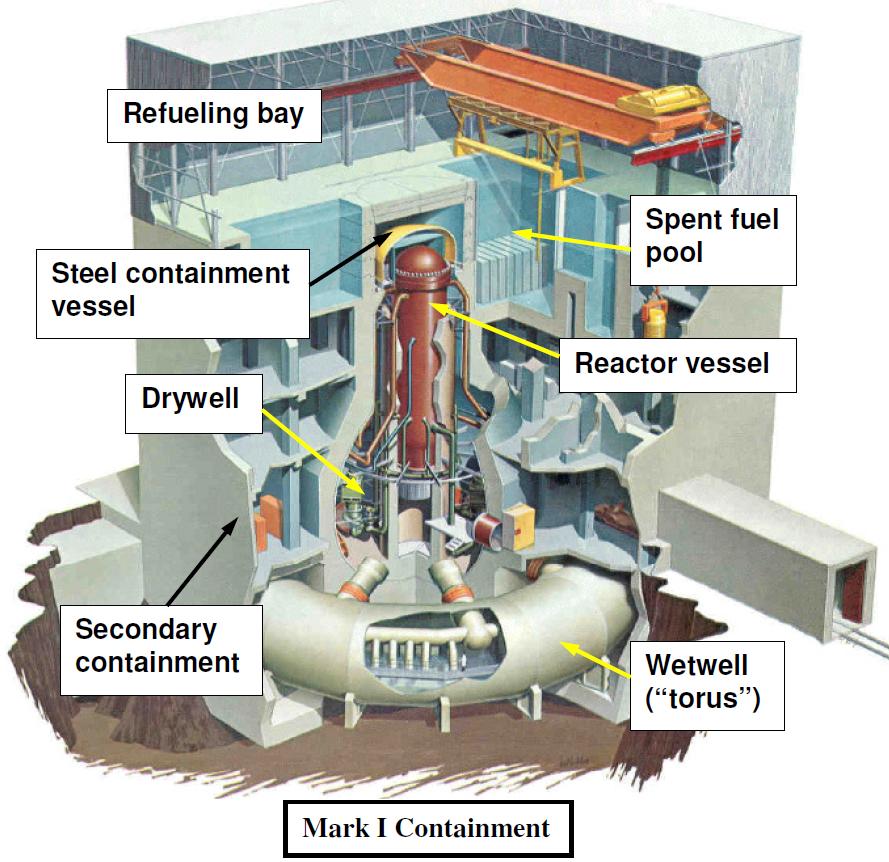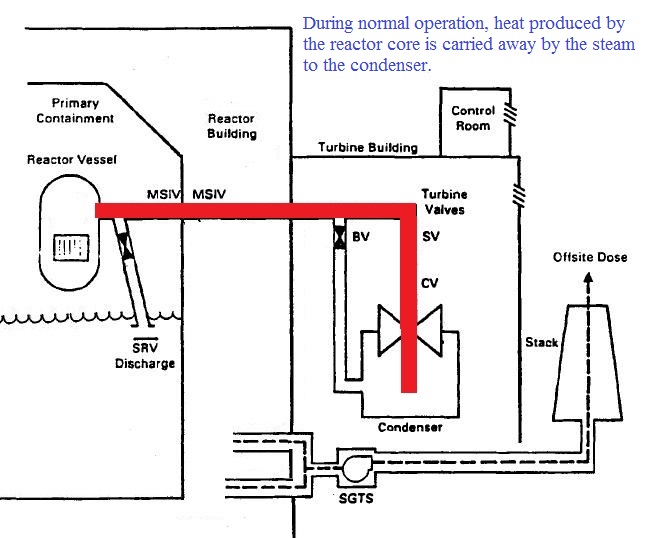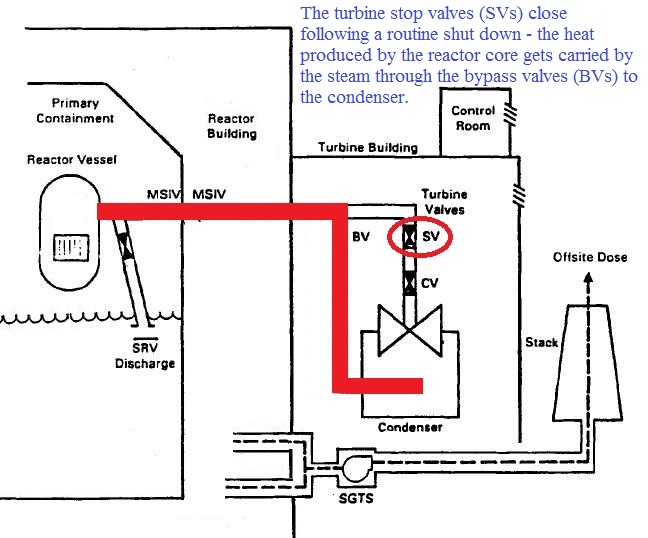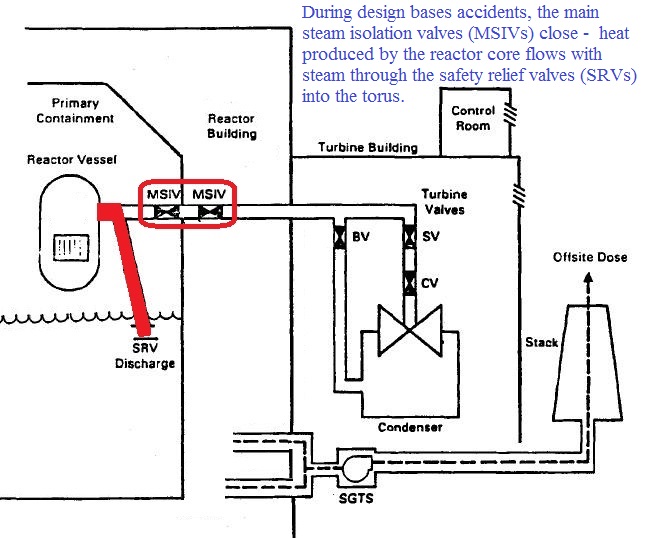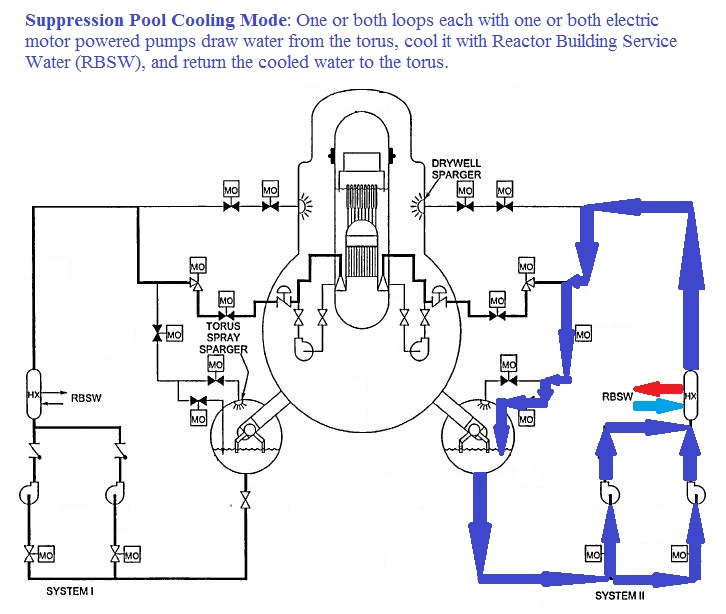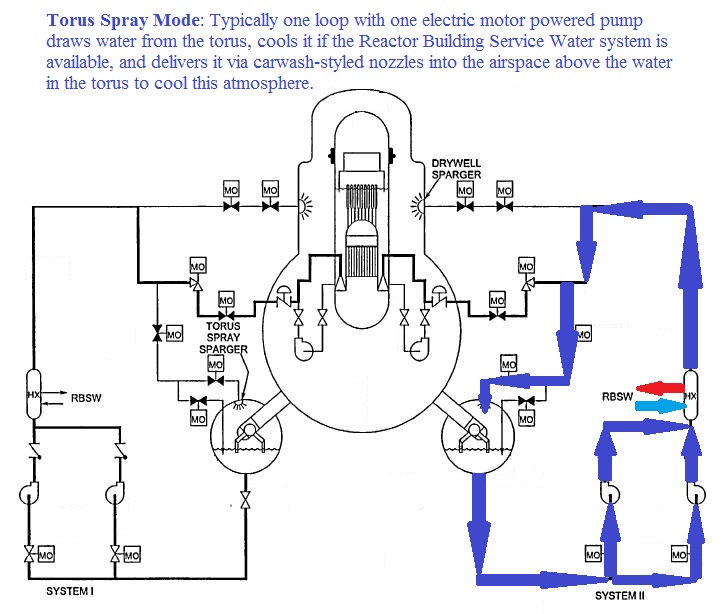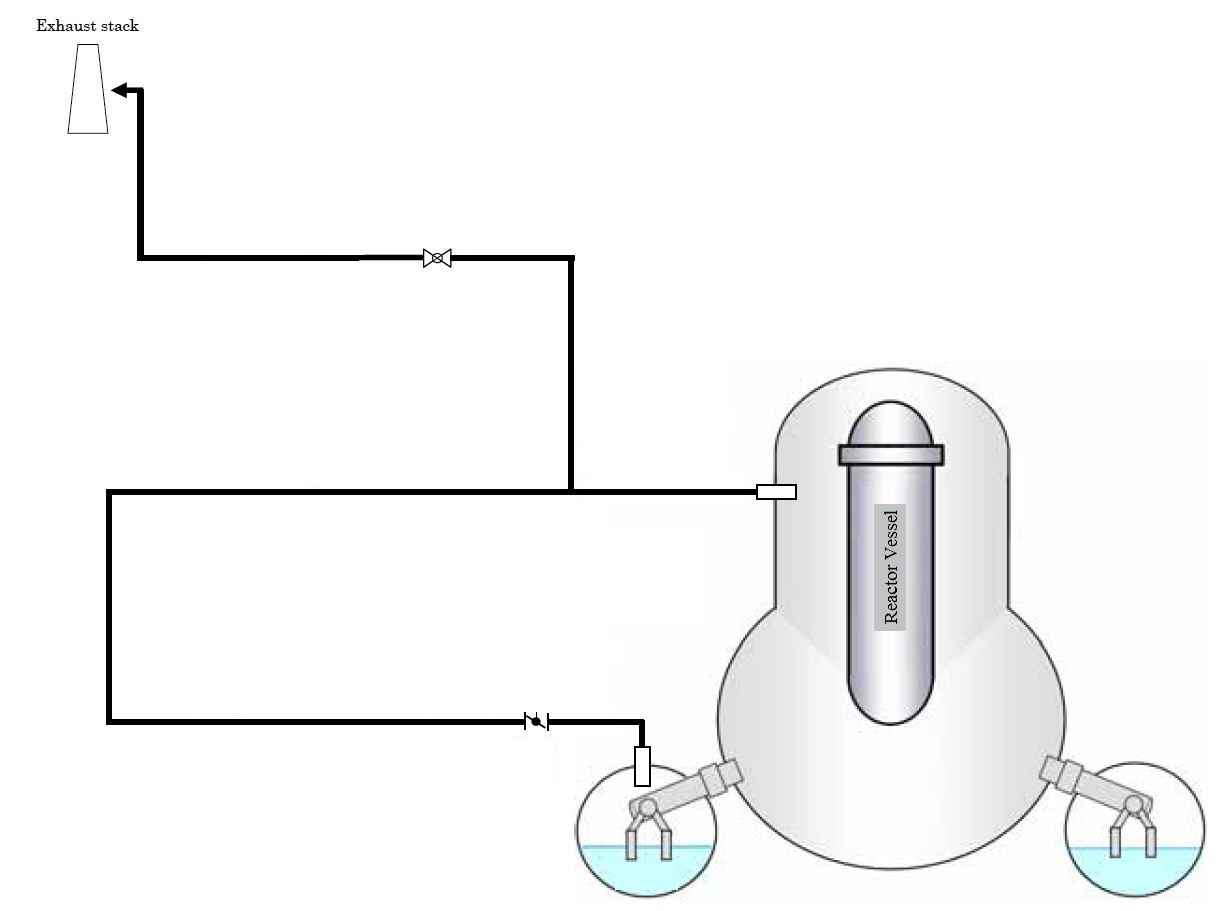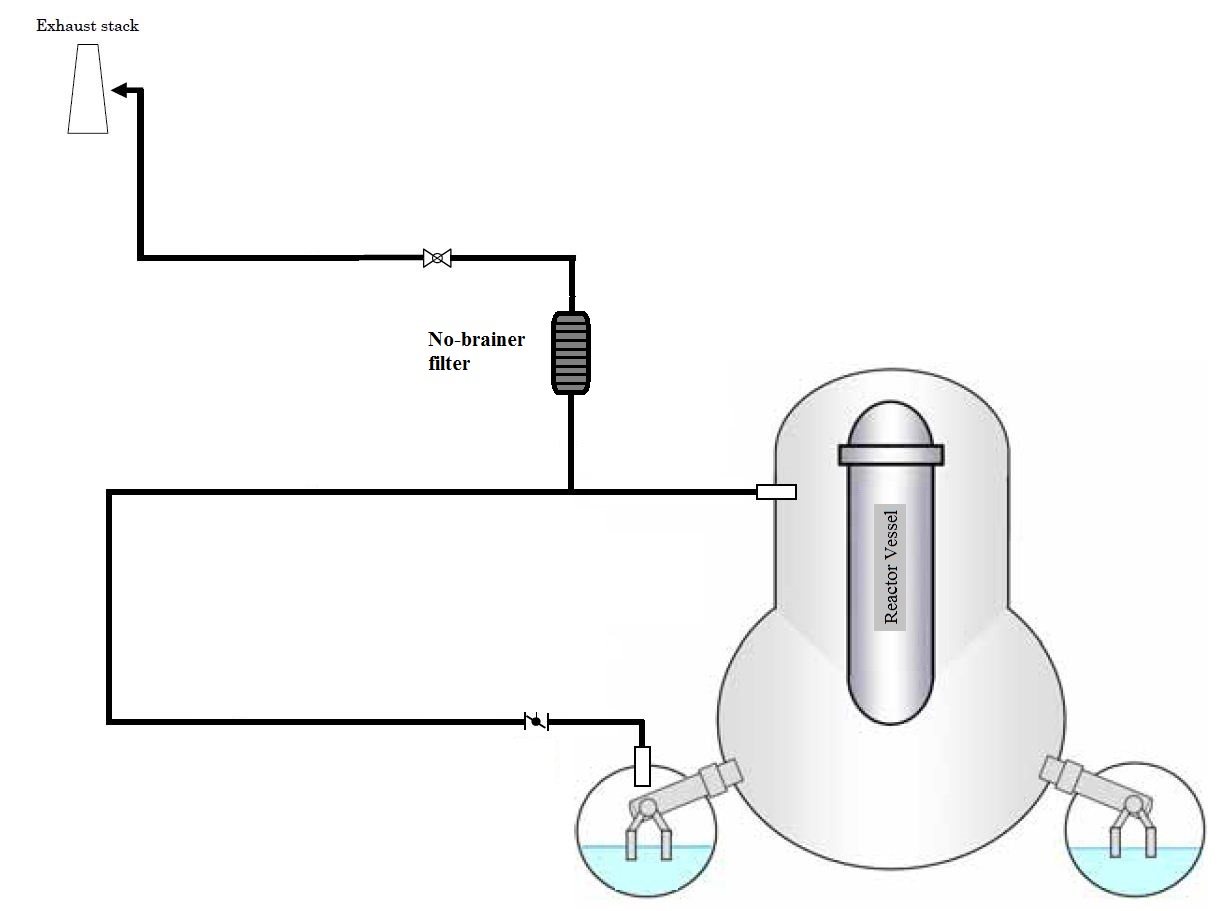There has been considerable discussion recently regarding appropriate lessons to be learned from Fukushima and applied to containment venting during severe reactor accidents.
Understanding the issue requires understanding the usual cooling systems a reactor uses. This post gives some brief background on containment venting to the atmosphere, why venting can become necessary to remove heat produced by the reactor core, and why filters are needed to reduce the environmental risks of venting.
Figure 1 shows a diagram of a boiling water reactor like several of the Fukushima reactors and roughly a third of the U.S. fleet. The reactor vessel at the center is surrounded by the hardened primary containment, which is made up of the drywell (the region around the reactor vessel that is surrounded by a steel and concrete shell) and the wetwell, or torus.
When this reactor is operating normally, the heat being produced by the reactor core gets carried away by the steam flowing through the turbine to the condenser (Figure 2). The steam is cooled by water from a nearby ocean, lake, or river (often aided by water recirculated through cooling towers) and converted back into water. The condenser functions as the conduit for the reactor’s heat to be discharged to the environment.
The primary containment housing the reactor vessel and the reactor core gets warmed by heat radiating from steam pipes and running motors. An air conditioning system cools the atmosphere inside the primary containment. Cool water flows through metal tubes while fans blow containment gas across the tubes for cooling similar to how air flowing past a radiator cools a car’s engine.
When a nuclear reactor shuts down, the turbine is taken out of service. Steam continues to remove the heat produced by the reactor core and bypasses the turbine to flow directly into the condenser (Figure 3). The air conditioning system continues to cool the primary containment atmosphere.
Design-bases accidents may render the the condenser and its connection to the nearby ocean, lake, or river unavailable. The main steam isolation valves (MSIVs) close to prevent potentially radioactive materials from getting out of the primary containment.
Considerable amounts of heat continue to be produced by a reactor core, even when it is shut down. If an accident shuts down the systems that normally remove water from the reactor vessel, cool it, and return the cooled water to the reactor vessel, the core’s heat boils water to make steam. To prevent the pressure within the reactor vessel from increasing to the point where piping or the vessel itself bursts, safety relief valves (SRVs) open to discharge steam into water within the torus (Figure 4).
During design-bases accidents, the primary containment continues to be cooled by fans blowing gas across water-filled tubes. If operating, the primary containment air conditioning system removes some of the heat being produced by the reactor core. But the bulk of the reactor core’s heat is flowing into the torus water.
The residual heat removal (RHR) system can be operated in several different modes to help cool the reactor core, primary containment, and torus water during design-bases accidents. In the low pressure coolant injection (LPCI) mode of operation, the RHR system transfers water from the torus into the reactor vessel to compensate for water being lost through a broken pipe or stuck open valve. Water pouring out of the broken pipe or open valve (red arrow in Figure 5) enters the primary containment where it flows down into the torus for recycling through the reactor vessel.
The suppression pool cooling mode of RHR takes water from the torus, routes it through heat exchanger(s) where it is cooled by the reactor building service water system (RBSW) (also called the residual heat removal service water or emergency service water system at some facilities), and the cooled water flows back to the torus (Figure 6).
As a backup to the primary containment’s air conditioning system, the RHR system can also spray cool water into the drywell part of the primary containment (Figure 7). Water from the torus is delivered through carwash-styled nozzles into the primary containment’s upper regions. This water cools the atmosphere inside the primary containment.
Likewise, the RHR system can take water from the torus and spray it into the air space above the water within the torus to cool the air in this region (Figure 8).
Containment Venting to the Atmosphere
In accident situations in which the cooling systems described above are not woking, heat produced by the reactor core is not removed from primary containment. Instead, this heat increases the temperature and pressure in the drywell and torus. Left unchecked, this will ultimately cause the containment to fail. Venting is used in this case to reduce both the temperature and pressure.
Venting air from primary containment to the atmosphere is the last-ditch means of cooling the containment. If any of the systems designed to cool the primary containment (drywell and torus) under either normal conditions or design-bases accidents work as planned, containment venting is not necessary. Put another way, containment venting is only necessary when all other primary containment and torus cooling systems have failed.
That is what happened at Fukushima. Failure of the cooling systems led to a pressure and temperature increase in the primary containment and ultimately required venting. With other cooling systems unavailable, “feed and bleed” became the only means of cooling the reactor core. The “feed” consisted of injecting water into the reactor vessel. This water absorbed the reactor core’s heat as it warmed to the boiling point and turned to steam. The steam further increased the pressure inside the reactor vessel. To control the pressure level inside the reactor vessel, steam was released (or bled) through the safety relief valves and into the torus water. Passing the steam through the torus water cooled it and condensed the steam back to water. This cooled the reactor vessel but increased the temperature and pressure of the torus. Eventually the torus had to be vented to the atmosphere to reduce its temperature and pressure (Figure 9).
Generally there are two options for venting the primary containment. One is venting the air above the water in the torus, as just described. This is the preferred option since any radioactivity in this space can only get there by flowing from the reactor vessel or drywell and being discharged beneath the surface of the torus water. The water acts as a filter since it retains some of the radioactive particles and gases, reducing the amount that reaches the torus air space and that is therefore released to the environment during venting.
Some emergency situations, however, require venting directly from the drywell to reduce the pressure. This also happened at Fukushima. If the RHR system were operating and could spray water into the drywell, this water would help remove radioactive particles and gases from the containment atmosphere, preventing this material from being released to the environment during venting.
But containment venting becomes necessary when all other available primary containment and torus cooling options have failed. In that situation, the temperature of the torus water will very likely approach or reach the boiling point and it’s unlikely that the RHR system will have sprayed down the drywell atmosphere. Hot and potentially boiling torus water does not effectively retain radioactive particles and gases en route to the torus air space. And lack of drywell spraying means the drywell atmosphere is laden with radioactivity. In both cases, venting releases radioactive gases to the atmosphere.
Unless, of course, there is a filter to scrub out the radioactive particles from the gas being vented (Figure 10).
The installation of the no-brainer filter in the common path between the torus and drywell vents and the outside world protects the public and workers. Period.
Lack of the no-brainer filter in the common vent path protects the public and workers only if an accident has occurred but the primary containment and torus cooling functions have not been lost. In other words, containment venting without the no-brainer filter works only when the containment is not vented.
This issue is a true litmus test for the NRC – does it value public safety more than financial performance by plant owners? The only reason not to install the no-brainer filters is to avoid spending a few dollars. There is no other reason.

